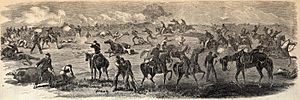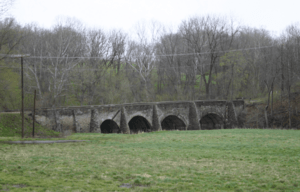Battle of Upperville facts for kids
Quick facts for kids Battle of Upperville |
|||||||
|---|---|---|---|---|---|---|---|
| Part of the American Civil War | |||||||
 The Battle of Upperville: Harper's Weekly, July 18, 1863. |
|||||||
|
|||||||
| Belligerents | |||||||
| Commanders and leaders | |||||||
| Alfred Pleasonton Strong Vincent |
Wade Hampton Beverly Robertson |
||||||
| Strength | |||||||
| 2 cavalry divisions 1 infantry brigade |
4 cavalry brigades | ||||||
| Casualties and losses | |||||||
| 209 | 180 | ||||||
The Battle of Upperville was a fight during the American Civil War. It happened on June 21, 1863, in Loudoun County, Virginia. This battle was part of the larger Gettysburg Campaign. It was a clash between the Union (Northern) and Confederate (Southern) armies.
Contents
Why the Battle Happened
The Union army's horse soldiers, called cavalry, wanted to find out where the main Confederate army was. Confederate General J.E.B. Stuart and his cavalry were trying to stop them. Stuart's job was to hide the location of General Robert E. Lee's main army. Lee's army was moving through the Shenandoah Valley, west of Upperville.
Stuart had been fighting small battles to slow down the Union cavalry. He used natural features like ravines, creeks, and stone walls to his advantage. He had already fought at Aldie and Middleburg. Stuart hoped to keep the Union soldiers from finding Lee's army.
Fighting at Goose Creek
After the fighting at Middleburg, a big rainstorm hit the area. This ended a long dry period. During the rain, Confederate General Wade Hampton brought his cavalry to help Stuart. They set up near Beverly Robertson's soldiers. Other Confederate groups also moved into position. John Mosby's special rangers helped by scouting Union positions. They gathered important information for Stuart.
Union cavalry commander Alfred Pleasonton was getting frustrated. Stuart's soldiers were good at fighting from behind stone walls. So, Pleasonton asked for help from the Union infantry (foot soldiers). He still needed to find Lee's main army, which was a big task from the War Department.
Pleasonton sent some of his cavalry, led by Judson Kilpatrick, down a main road. They were supported by Strong Vincent's infantry. Another cavalry group, led by John Buford, tried to attack from the side.
On June 21, Stuart's men were hoping for a rest. But Union cannons started firing around 8:00 a.m. Stuart's soldiers fought hard, using stone walls and steep creeks for cover. But the Union infantry pushed them back.
They made a strong stand at the stone bridge over Goose Creek. For two hours, they held off repeated Union attacks. Even the 16th Michigan Infantry sent sharpshooters to target the Confederate gunners.
As the Union soldiers advanced, the Confederate cannons tried to escape. One cannon, a Blakely Rifle, flipped over and was captured. This was the first time Stuart's cavalry had lost a cannon. With two more cannons disabled, Stuart had to pull back. He headed west toward Upperville, still fighting to slow the Union advance.
The Battle for Upperville
John Buford's Union soldiers took a different path to attack the Confederate left side near Upperville. Meanwhile, other Union brigades, led by J. Irvin Gregg and Judson Kilpatrick, came from the east. Buford soon met Confederate brigades guarding Stuart's supply wagons north of Upperville and attacked them.
Kilpatrick's soldiers attacked Hampton and Robertson on a hill east of Upperville. Some Union cavalry even reached the village itself before being pushed back.
After fierce fighting, Stuart finally pulled his forces back to a strong defensive spot at Ashby's Gap. At the same time, Confederate infantry began crossing the Potomac River into Maryland. As the cavalry fights died down, Stuart made a big decision. He decided to ride around the Union army as it marched toward Gettysburg.
The Battle of Upperville was important because Stuart's delaying tactics worked. He stopped the Union commander, Pleasonton, from finding out where Lee's main army was. This meant the Union army didn't have important information about their enemy's plans.
Battlefield Preservation
Organizations like the Civil War Trust have worked to protect parts of the Upperville battlefield. They have saved over 800 acres (about 3.2 square kilometers) of this historic land.


